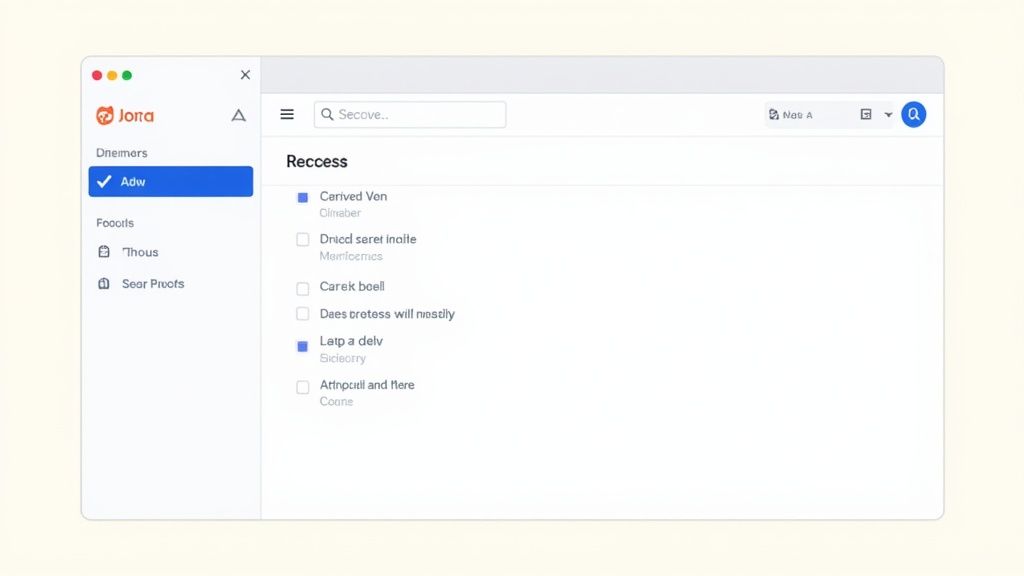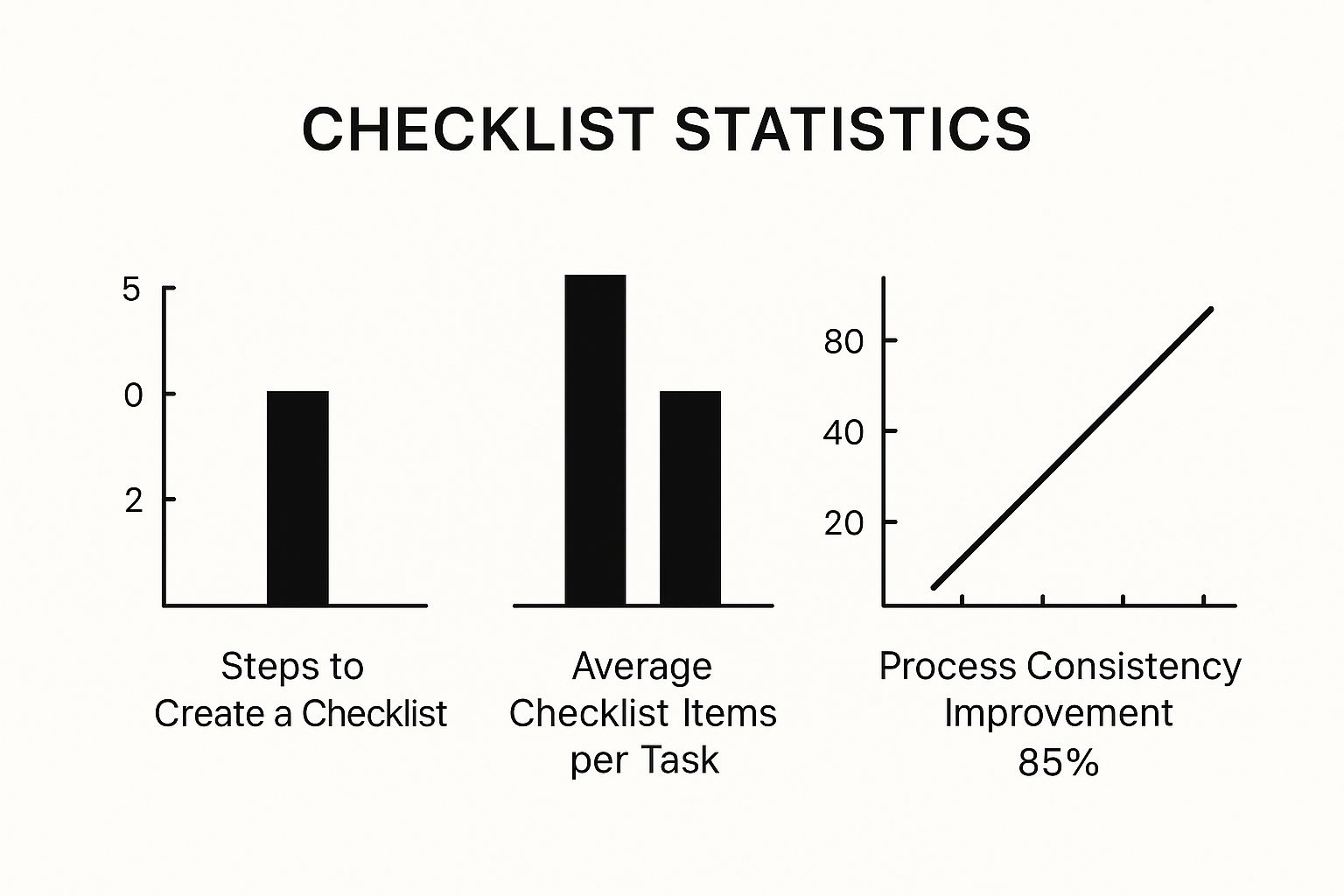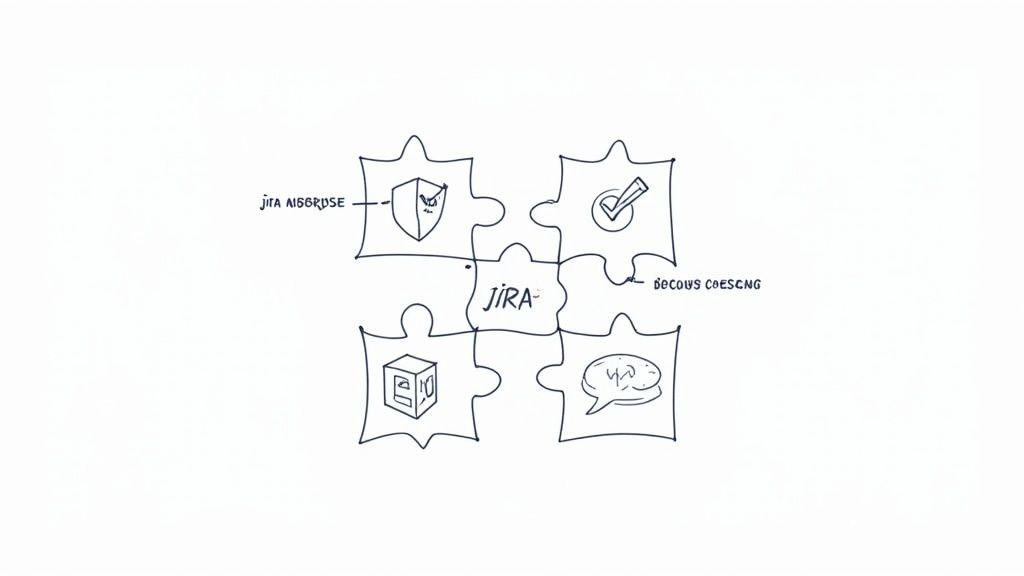Why Checklists Transform How Teams Work

Many teams grapple with disorganized tasks and missed deadlines. Checklists in Jira offer a solution to this common problem. Savvy project managers are increasingly integrating checklists to bring structure to their projects.
They act as a link between overarching project strategies and the daily tasks required for completion. This connection builds a stronger sense of responsibility within the team.
The Psychology Behind Checklist Effectiveness
Checklists are effective because they complement our natural cognitive processes. They reduce the mental strain of remembering every single task, freeing up mental capacity for strategic thinking. This shift allows teams to concentrate on the project goals rather than the minute details of execution.
For example, a new employee onboarding checklist ensures consistent execution of every important step. This consistency minimizes confusion and prevents unnecessary delays.
Tangible Benefits of Checklists in Jira
This increased efficiency yields measurable improvements. Teams utilizing checklists frequently experience a significant rise in on-time project delivery. This means projects are finished more quickly and with fewer obstacles.
Furthermore, checklists provide a clear progress record, simplifying the process of identifying roadblocks and improving workflows. Tracking checklist performance after implementation is essential. For additional insights on measuring automation success, check out this resource on measuring the success of your sales automation strategy.
To further illustrate the advantages of checklists, let’s examine a comparison of key metrics. The following table showcases the improvements observed when transitioning from traditional task management to a checklist-based approach.
Benefits of Using Checklists vs Traditional Task Management
Comparison of productivity metrics and team outcomes between checklist-based and traditional task management approaches
| Metric | Traditional Tasks | Checklist-Based | Improvement % |
|---|---|---|---|
| On-Time Project Delivery | 60% | 85% | 41.7% |
| Task Completion Rate | 70% | 90% | 28.6% |
| Error Reduction | 10 errors/project | 4 errors/project | 60% |
| Time Saved per Project | 10 hours | 15 hours | 50% |
As the table demonstrates, incorporating checklists leads to significant improvements across various performance indicators. The most notable gains are observed in on-time project delivery, error reduction, and time saved per project. These improvements underscore the value of checklists in enhancing team efficiency and overall project outcomes.
Streamlining Work with Checklists
Checklists simplify complex projects by breaking them into smaller, manageable steps. This clarity empowers team members to understand their individual roles and contribute effectively to the project’s overall success. For example, a software release checklist guarantees that all testing and deployment procedures are followed prior to launch. This meticulous approach reduces the chance of serious errors. For deeper insights into Jira capacity planning, explore this helpful guide.
By providing a structured approach to task management, checklists in Jira promote clear communication, efficient execution, and ultimately, project success. They are a practical and effective tool for managing complexity, improving team collaboration, and achieving consistent, positive results.
Jira’s Native Checklist Features That Actually Work

Beyond the basic benefits of checklists, let’s explore their practical use within Jira. Jira now offers native checklist management features, eliminating the need for complex workarounds or expensive third-party add-ons. Teams can now utilize built-in functionality for a more streamlined workflow.
Action Items: A Game Changer for Checklists in Jira
A significant improvement came with the 2025 introduction of Action Items. This feature provides a more integrated approach to task management within Jira. Previously, teams often resorted to using subtasks or custom checkbox fields, which were less than ideal. Action Items improve collaboration with a more intuitive and efficient way to manage checklists directly within Jira issues. This aligns with Atlassian’s focus on enhanced user experience and workflow improvements. Learn more about the Jira Checklist 2025 updates.
Why Native Features Often Win
Jira’s native Action Items offer several advantages over third-party solutions for many teams. Seamless integration with Jira’s core features avoids compatibility problems and simplifies updates. Plus, native features are readily available to all Jira users, removing the need for extra licenses or training.
- Simplified Setup: Create and manage Action Items easily within Jira issues, minimizing setup time.
- Enhanced Collaboration: Track progress, assign responsibilities, and collaborate on checklist items within the same Jira issue.
- Reduced Complexity: Native features eliminate the need for extra apps and configurations, streamlining the overall workflow.
Practical Implementation of Action Items
This simplicity translates to a better user experience and increased adoption rates. Imagine building a software release checklist within the associated Jira issue. Every team member can then view and update their assigned tasks, increasing accountability and transparency. This reduces the likelihood of missed steps and makes project tracking easier. You might also be interested in: How to master Jira workflows.
Using native features also encourages consistency across projects and teams. Jira’s standardized checklist management approach promotes better collaboration and minimizes errors. By utilizing these features, teams can efficiently achieve project goals and reduce administrative overhead.
Third-Party Apps That Extend Your Checklist Power
Jira’s built-in checklist features provide a good starting point for basic task management. But when your team requires more advanced functionality, third-party apps can significantly enhance Jira checklists. These apps cater to diverse team sizes and project complexities, offering a range of features beyond Jira’s native capabilities.
Exploring the App Landscape
The Atlassian Marketplace offers a wide selection of apps to boost your Jira checklists. These apps often include features like mobile access, advanced automation, and robust integrations with other platforms. Selecting the right app depends on your team’s specific requirements, such as team size, project scope, and budget.
Some teams may prioritize seamless integration with Confluence, while others may need advanced reporting. Finding the right balance between functionality and cost is essential. The infographic below highlights key data points about using checklists in Jira: the number of steps to create a checklist, average checklist items per task, and the improvement in process consistency after implementing checklists.

The infographic shows that creating a checklist in Jira takes only five steps, and the average task includes about seven checklist items. Remarkably, using checklists has resulted in an 85% improvement in process consistency.
Choosing the Right App for Your Team
Using checklists in Jira, especially with third-party apps, is now critical for maintaining high-quality work. An app like Didit Checklists for Jira allows users to create and manage checklists in both Jira and Confluence. This integration benefits organizations seeking to streamline processes and ensure consistency. Didit also lets external users complete checklists via a browser or mobile app, enhancing collaboration. Recurring checklist templates in Didit save time and reduce clutter in your Jira instance. For a deeper dive into Jira checklists, explore the Ultimate Jira checklists guide.
Several factors should guide your decision when selecting a third-party app. Key considerations include:
- Integration Level: How well does the app integrate with other tools in your workflow, like Confluence or Slack?
- Mobile Accessibility: Is it possible for team members to access and update checklists from their mobile devices? This is vital for remote or field-based teams.
- Advanced Automation: Does the app provide automated checklist creation, assignment, or updates based on Jira triggers or events?
- Collaboration Features: Can multiple users work on and track progress on shared checklists?
- Pricing: Does the app have a free tier or is it subscription-based?
The following table compares key features of popular Jira checklist apps:
Top Jira Checklist Apps Feature Comparison
Detailed comparison of leading third-party checklist applications including features, pricing, and integration capabilities
| App Name | Key Features | Integration Level | Mobile Support | Pricing Model |
|---|---|---|---|---|
| Didit Checklists for Jira | Recurring checklists, external access, Confluence integration | High (Jira, Confluence) | Yes | Subscription |
| Checklist for Jira | Customizable checklist templates, progress tracking | Medium (Jira) | Yes | Subscription |
| Smart Checklist for Jira | Conditional checklists, due dates | Medium (Jira) | Limited | Free and Subscription |
This table summarizes the core features, integration capabilities, mobile support, and pricing models of these leading apps, allowing for a quick comparison to help you choose the best fit for your needs.
Maximizing Checklist Power with Integrations
By carefully evaluating these factors, you can select the app that best extends your checklist power in Jira. The right app can drastically improve team productivity and ensure smooth project execution, even for complex projects. This results in greater efficiency and improved project outcomes.
Building Checklist Templates That Teams Actually Use
The success of checklists in Jira depends heavily on well-designed templates. A poorly designed template can lead to abandoned checklists and frustrated team members. This section explores proven template structures that adapt to the realities of projects while maintaining consistency.
Learning From Successful Teams
Teams effectively using checklists in Jira often create templates for recurring processes. These processes could include software releases, marketing campaigns, or onboarding new employees. These templates provide a structured framework while allowing for flexibility. Balancing structure and adaptability is key for maximizing efficiency and encouraging innovation.
For example, a software release checklist template might include sections for testing, documentation, and deployment. Each section can then be customized with tasks specific to each release. This ensures consistent execution of important steps while accommodating variations between releases.
Balancing Standardization and Flexibility
Effective checklist templates balance standardization and flexibility. Standardized templates ensure consistency across different projects and teams. However, overly rigid templates can stifle innovation and become impractical for unique projects.
Templates should handle routine tasks while adapting to unique project requirements. Think of it like a recipe: you follow the basic steps for baking a cake, but you can adjust the flavor and decorations. Similarly, Jira checklists provide a structured framework that teams can customize to fit specific project needs.
Building Your Checklist Template: A Step-by-Step Guide
Building effective Jira checklist templates involves these steps:
- Define the scope: Clearly define the process the checklist will cover. What is its purpose? Onboarding? Software releases? Something else entirely?
- Identify key tasks: List all the necessary steps in the process. Break complex tasks into smaller, manageable steps.
- Group related tasks: Organize tasks into logical sections or categories for improved clarity.
- Include assignees and due dates: Assign responsibility for each task and set deadlines where appropriate.
- Add supporting information: Include links to relevant documentation, resources, or guidelines.
- Test and refine: Test the template with your team and gather feedback to improve it.
Downloadable Examples and Customization
To get started quickly, consider using downloadable templates. These templates can be adapted to your team’s workflow and project requirements. Explore our examples and step-by-step guidance on template customization. This practical approach will help you master Jira checklist templates and improve your team’s performance.
Smart Automation That Makes Checklists Work Harder

Manually managing checklists in Jira can be a drain on your team’s time. This section explores how automation can transform these checklists into dynamic, self-managing systems, freeing up your team to focus on more strategic initiatives.
Automating Checklist Creation and Population
Imagine checklists that generate automatically based on the issue type. Creating a “New Employee Onboarding” issue, for example, could automatically populate a checklist with all the necessary onboarding steps. This eliminates manual setup and ensures consistency across the entire onboarding process.
Checklists can also adapt based on project phases. As a project transitions from “Planning” to “Execution,” the relevant checklist automatically appears, guiding the team through the required tasks for that specific stage. This dynamic adaptation keeps everyone on track and minimizes the risk of overlooking crucial steps. You might be interested in: How to master Jira Cloud Automation.
Here are a few examples of triggers that can automate checklist population:
- Issue Type: Assign specific checklists to individual issue types.
- Project Phase: Dynamically change checklists as the project progresses through different phases.
- Team Assignment: Trigger dedicated checklists based on the team assigned to the issue.
Advanced Automation Scenarios
Automation with checklists in Jira can achieve much more than simple creation. The completion of checklist items can trigger workflow transitions. For example, finishing the “Testing” checklist in a software release could automatically move the issue to the “Deployment” stage, streamlining the entire release process.
Smart notifications can also be triggered upon checklist completion, keeping everyone informed of progress without constant Jira monitoring. Furthermore, updates to related issues can be automated, ensuring data consistency across all aspects of the project.
Building a Self-Managing System with Checklists in Jira
By integrating these automation features, teams can create truly self-managing systems within Jira. These systems reduce the need for constant oversight while ensuring that no critical steps fall through the cracks, especially beneficial for complex projects where manual tracking becomes unwieldy.
Troubleshooting and Optimization
When dealing with complex integrations, effective troubleshooting and performance optimization are essential. Regularly monitoring automation performance and promptly addressing any issues will ensure your Jira checklists continue to operate smoothly. By implementing these automated processes, your team can significantly boost efficiency and reduce errors, ultimately focusing on delivering value rather than managing tedious manual tasks.
Making The Move To Jira Cloud Without Breaking Everything
Migrating to Jira Cloud doesn’t have to mean abandoning your team’s established checklist workflows. A well-planned transition ensures continued productivity during the move from on-premises systems. This involves three key areas: preserving existing data, adapting workflows for the cloud, and effective team training.
Data preservation, for example, focuses on carefully transferring your existing Jira checklists to the cloud. This meticulous approach helps ensure no critical information is lost during migration. Workflow translation adapts your Jira checklist procedures to the cloud version, accounting for any feature differences.
The shift to cloud-native solutions like Jira Cloud is accelerating. Gartner predicts that by 2025, 95% of new digital workloads will be cloud-native. This necessitates a smooth migration, particularly for established workflows like checklists. Confluence can be a valuable tool for gathering feedback and refining configurations during this process. Learn more about preparing for a Jira migration here. This resource emphasizes the importance of careful planning and execution for a successful cloud migration.
Key Strategies for a Smooth Transition
Successful migrations often benefit from a phased approach, enabling incremental adjustments and consistent feedback collection. Consider breaking the process down into manageable stages.
- Data Preservation: Accurately transfer all Jira checklists and associated data to the cloud environment.
- Workflow Translation: Adapt your existing checklist procedures to Jira Cloud, addressing any functional variations.
- Team Training: Prepare your team to effectively use checklists within the new cloud environment.
This structured approach minimizes disruptions and promotes a smoother overall transition. For automating Pinterest tasks, you might consider a Pinterest Scheduler. You may also find this resource helpful: How to master the HubSpot Jira Integration.
Testing and Refinement
Thorough testing before the full launch is critical. This helps identify potential issues and allows for necessary adjustments. Gather feedback from your team throughout the process to further refine the setup. This ensures your cloud configuration aligns with your team’s needs and maximizes checklist effectiveness. By implementing these strategies, you can transition to Jira Cloud without compromising productivity or data integrity.
Measuring What Matters For Checklist Success
Numbers are crucial, but understanding them in the context of your project is paramount. Simply tracking numbers without analyzing their meaning won’t provide useful information. This section explores the Key Performance Indicators (KPIs) that truly reflect how checklists in Jira affect your team’s performance.
Setting Up Meaningful Dashboards
Imagine a dashboard that not only shows checklist completion rates but also links them to time-to-completion data. This connection highlights efficiency gains from structured task management with checklists. Furthermore, linking checklist progress to the overall project delivery impact demonstrates the true value checklists bring to project success. For deeper insights, you might be interested in How to master SLA in Jira.
This comprehensive view, including completion rates, time efficiency, and project outcomes, provides a complete understanding of checklist effectiveness. It transforms raw data into a story of progress and pinpoints areas for improvement.
A/B Testing and Adoption Patterns
Just as marketers analyze website traffic, studying checklist adoption and usage patterns provides valuable information. A/B testing different checklist structures reveals what works best for your team. For example, comparing a detailed checklist with a shorter version might reveal that brevity encourages higher completion rates without compromising quality.
This iterative approach to checklist design is similar to refining a product based on user feedback. By analyzing what is effective and what isn’t, you keep checklists relevant, practical, and useful for your team.
Building a Culture of Continuous Improvement
Using checklists is not a one-time solution; it’s an ongoing process of refinement. Regularly reviewing checklist effectiveness, gathering feedback, and updating templates builds a culture of continuous improvement. This ongoing evaluation and optimization helps your team get the most from checklists in Jira, aligning with Agile methodologies.
This cyclical process of feedback and adjustment is key to long-term success with checklists. It reinforces their role as a dynamic tool for ongoing process optimization, driving measurable ROI from your Jira investment. This ultimately creates a more efficient, adaptable, and successful team.
Are you ready to improve your team’s workflows and increase productivity? Consider Out of Office Assistant for Jira Cloud to automate processes and ensure smooth task management, even when team members are away. This tool automates handovers and maintains uninterrupted workflows, allowing your team to deliver faster and take well-deserved breaks.
